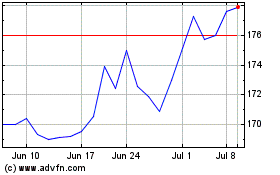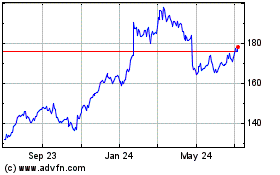By Katy Burne and Telis Demos
A Federal Reserve-sponsored task force is preparing to unveil
proposals by financial institutions, payments providers, trade
groups and others to improve the decades-old U.S. systems for
moving money electronically.
The faster payments task force, which is set to publish a
summary report of the work on Friday, rated 16 proposals that met
or exceeded predetermined criteria for speed and security,
developed in consultation with the central bank, according to a
copy viewed Thursday by The Wall Street Journal.
The task force includes more than 300 representatives taken from
federal agencies, banks, consumer groups, technology firms and
merchants such as Wal-Mart Stores Inc. and Lyft Inc. Consulting
firm McKinsey & Company helped assess the proposals, which come
from industry groups such as The Clearing House, a payments
operator owned by U.S. banks that is working with International
Business Machines Corp. and Mastercard's VocaLink, and the
Independent Community Bankers of America as well as payments
software startups Dwolla Inc., nanoPay Corp. and Ripple.
The report caps a two-year effort to identify safer and speedier
ways to transfer money digitally between bank accounts. The new
approaches, many of which are designed to settle transfers in real
time, could allow companies to collect funds or pay employees
instantaneously and save money by bypassing intermediaries.
Already, debit cards using networks operated by Visa Inc. and
Mastercard Inc. offer instant transfer options. And a group of the
biggest banks recently expanded a network, Zelle, for instant
transfers between consumers. But many of the older payment systems
remain much slower.
"Our goal is to ensure that anyone, anywhere, is able to pay and
be paid quickly and securely," said Sean Rodriguez, the Fed's
faster payments strategy leader and chair of the task force. "In
real terms, that means people will not have to wait hours or days
to deliver and access their money."
While the current system is viewed as both reliable and
universal, this process aims to spur the U.S. to keep pace with
similar upgrades to domestic payments systems in such countries as
Australia and the U.K.
"Innovators have built new systems and services that ride on top
of the old rails but with mixed results, and over time our system
has grown more fragmented," said Fed governor Jerome Powell in a
March speech.
The Fed doesn't have the legal power to mandate changes to the
U.S. payment system. Its interest in the matter stems from its
regulation of big banks, as well as its operation of parts of the
existing system, such as Fedwire, a same-day funds transfer service
for banks and businesses, and check clearing.
The Fed has said the task force didn't set out to pick winners
and losers and that the central bank wasn't endorsing any one
provider.
"The next step will be, OK, you've these 16 pieces, now how do
we tie them together?" said Cary Whaley, first vice president at
Independent Community Bankers of America.
Industry and task force participants hope the new report will
serve as a sort of starting gun for the adoption of newer systems.
It could encourage a shift away from some used today by banks,
including one called the Automated Clearing House, or ACH. The ACH
network handles more than $40 trillion of direct deposits, bill
payments and other transfers each year, and traces its roots to the
1970s.
Janet Estep, chief executive of ACH administrator NACHA and a
member of the task force's steering committee, said ACH has some
"core competencies that are hard to duplicate" and added that it
introduced some same-day settlements last year.
"All electronic payments today are focused on the same goal:
taking cash and checks out of the payments ecosystem," she
added.
A side benefit of the task force's work could be the development
of systems better protected from cyberattacks, and with more
granular data, enabling businesses and bill payers to embed
invoices and other detailed information in electronic
transfers.
Faster transfers could also help companies pay so-called "gig"
workers instantly, and reduce the need for underbanked consumers,
those without bank accounts or credit, to seek expensive payday
loans while waiting for their paychecks to clear.
"Faster payments can help ensure increased control over cash
flow, better money management, and decreased reliance on short-term
credit," said Christina Tetreault, a staff attorney with Consumers
Union and a task force steering committee member.
It remains to be seen how any new system will evolve, and
whether any of the proposals would be widely adopted, or how costly
it could be to do so.
The 16 proposals were drawn from 19 that had been received as of
January.
Write to Katy Burne at katy.burne@wsj.com and Telis Demos at
telis.demos@wsj.com
(END) Dow Jones Newswires
July 20, 2017 18:47 ET (22:47 GMT)
Copyright (c) 2017 Dow Jones & Company, Inc.
International Business M... (NYSE:IBM)
Historical Stock Chart
From Aug 2024 to Sep 2024

International Business M... (NYSE:IBM)
Historical Stock Chart
From Sep 2023 to Sep 2024
